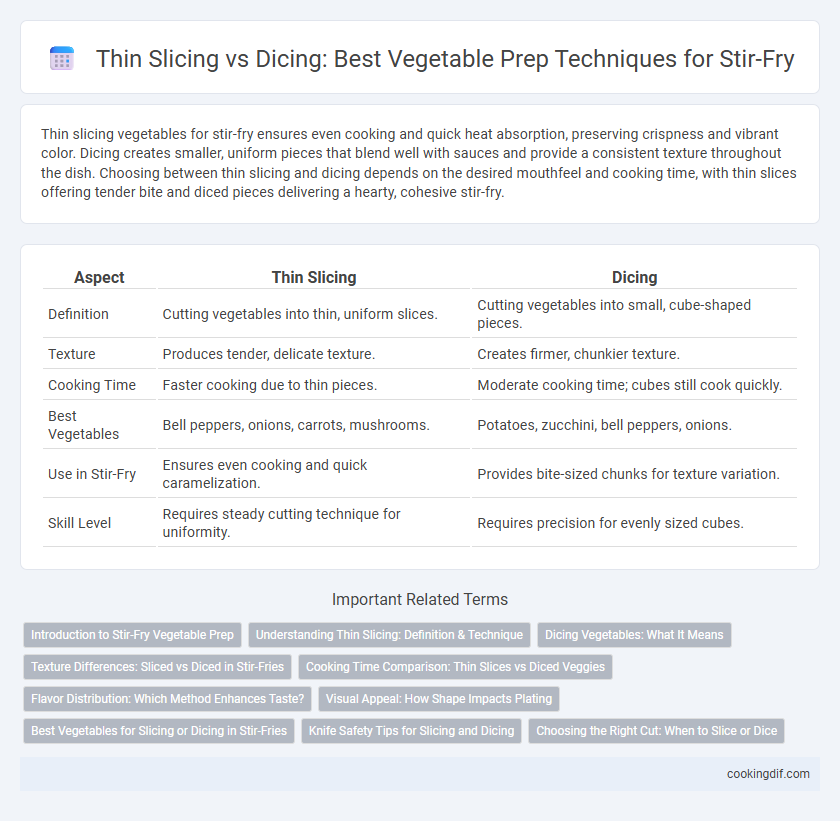Thin slicing vegetables for stir-fry ensures even cooking and quick heat absorption, preserving crispness and vibrant color. Dicing creates smaller, uniform pieces that blend well with sauces and provide a consistent texture throughout the dish. Choosing between thin slicing and dicing depends on the desired mouthfeel and cooking time, with thin slices offering tender bite and diced pieces delivering a hearty, cohesive stir-fry.
Table of Comparison
| Aspect | Thin Slicing | Dicing |
|---|---|---|
| Definition | Cutting vegetables into thin, uniform slices. | Cutting vegetables into small, cube-shaped pieces. |
| Texture | Produces tender, delicate texture. | Creates firmer, chunkier texture. |
| Cooking Time | Faster cooking due to thin pieces. | Moderate cooking time; cubes still cook quickly. |
| Best Vegetables | Bell peppers, onions, carrots, mushrooms. | Potatoes, zucchini, bell peppers, onions. |
| Use in Stir-Fry | Ensures even cooking and quick caramelization. | Provides bite-sized chunks for texture variation. |
| Skill Level | Requires steady cutting technique for uniformity. | Requires precision for evenly sized cubes. |
Introduction to Stir-Fry Vegetable Prep
Thin slicing vegetables ensures quick and even cooking in stir-fry dishes, preserving their crisp texture and vibrant flavor. Dicing offers uniform pieces that blend seamlessly in sauces but may alter the traditional stir-fry's rapid cooking rhythm. Choosing the right cut impacts cooking time and texture, essential for achieving authentic stir-fry results.
Understanding Thin Slicing: Definition & Technique
Thin slicing in stir-fry preparation refers to cutting vegetables into uniform, narrow slices typically 1-2 millimeters thick, which ensures quick and even cooking. This technique maximizes surface area exposure to high heat, preserving texture and enhancing flavor infusion during rapid stir-frying. Mastery of thin slicing requires sharp knives and steady hand control to maintain consistent thickness, optimizing both visual appeal and cooking efficiency.
Dicing Vegetables: What It Means
Dicing vegetables involves cutting them into small, uniformly sized cubes that promote even cooking and consistent texture in stir-fry dishes. Precise dicing ensures that each vegetable piece absorbs flavors evenly while maintaining a balanced crunch and tenderness. Choosing the right dicing size enhances the visual appeal and performance of the stir-fry, contributing to a well-executed dish.
Texture Differences: Sliced vs Diced in Stir-Fries
Thin slicing vegetables in stir-fries creates longer, tender strips that cook quickly and retain a slightly crisp texture, enhancing the dish's overall mouthfeel. Dicing results in smaller, uniformly sized pieces that cook evenly and absorb sauces more thoroughly, providing a more consistent texture throughout the stir-fry. Choosing between thin slicing and dicing affects the balance of crunch and softness, influencing both the visual appeal and taste experience of the meal.
Cooking Time Comparison: Thin Slices vs Diced Veggies
Thin slicing vegetables creates larger surface areas exposed to heat, allowing faster and more even cooking compared to dicing, which produces smaller, uneven pieces that may cook inconsistently. Thin slices typically cook within 2-3 minutes in a stir-fry, while diced vegetables require 4-5 minutes to achieve a similar tenderness due to their varied sizes. Optimizing vegetable prep by thin slicing helps maintain vibrant texture and reduces overall cooking time, enhancing stir-fry efficiency and flavor.
Flavor Distribution: Which Method Enhances Taste?
Thin slicing vegetables in stir-fry ensures faster cooking and better absorption of sauces, enhancing overall flavor distribution. Dicing creates smaller, uniform pieces that release more surface area, intensifying taste but requiring precise timing to avoid overcooking. Choosing between thin slicing and dicing depends on the desired texture and how evenly the flavors meld during the stir-frying process.
Visual Appeal: How Shape Impacts Plating
Thin slicing vegetables in stir-fry enhances visual appeal by creating uniform, elongated pieces that lay flat and showcase vibrant colors, making the dish look more refined and appetizing. Dicing produces compact, cube-shaped pieces that offer a chunky texture and a mosaic-like plating effect, adding dimensionality and a hearty aesthetic. The choice between thin slicing and dicing directly influences the stir-fry's presentation by balancing texture contrast with visual symmetry, elevating the overall dining experience.
Best Vegetables for Slicing or Dicing in Stir-Fries
Thin slicing enhances rapid, even cooking and is ideal for vegetables like bell peppers, carrots, and zucchini in stir-fries. Dicing works best with denser vegetables such as onions, potatoes, and mushrooms to ensure uniform texture and flavor absorption. Choosing the right cut optimizes heat distribution and maintains the natural crispness and color of each vegetable.
Knife Safety Tips for Slicing and Dicing
Thin slicing and dicing vegetables require precise knife control to ensure clean cuts and maintain even cooking. Always use a sharp knife and keep fingertips curled under the guiding hand to prevent accidental cuts. Maintaining a stable cutting board and applying consistent pressure during slicing or dicing enhances both safety and efficiency in stir-fry preparation.
Choosing the Right Cut: When to Slice or Dice
Choosing the right cut for stir-fry vegetables depends on cooking time and texture preference; thin slicing ensures quick, even cooking and a tender bite, while dicing offers a chunkier texture that holds up well in longer cooking processes. Vegetables like bell peppers and carrots benefit from thin slicing to maximize surface area and flavor absorption, whereas denser vegetables like potatoes or onions are better diced for consistent cooking. Properly matched cuts optimize texture, flavor release, and overall dish balance in stir-fry preparations.
Thin slicing vs Dicing for vegetable prep Infographic

 cookingdif.com
cookingdif.com